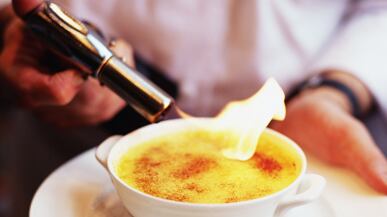About halfway through his lecture, Wylie Dufresne pulls out a blowtorch and blasts a piece of foie gras with several hundred degrees of heat. One might have expected the delicate slice of duck liver to melt under the blistering temperature, but instead the top took on a deep brown crust.
"You can see that it's taken a direct hit and is still smiling," Dufresne says to a round of applause from the audience. His secret? Before molding the foie gras, he added a naturally occurring enzyme called transglutaminase—otherwise known as meat glue—that creates strong bonds between animal proteins. The result was a firmer texture that somehow kept its shape, rather than liquefying.
The crowd had come to listen to the owner of wd-50—a highly acclaimed New York City restaurant known for pushing the culinary envelope—talk about utilizing science to improve food. Throughout the evening, he wowed those assembled with gastronomic experiments that ranged from making shrimp spaghetti —without flour!—to attaching two pieces of Wagyu flap steak and then searing it. "The covalent bonds… are so strong that you can't break them down by heat," explained Dufresne. "But the pH of your stomach can break down the meat glue."
You wouldn't expect a chef, world-renowned or not, to throw around the term covalent bond, but this was no ordinary cooking demonstration. It was part of the school's most popular class and public lecture series, "Science and Cooking: From Haute Cuisine to the Science of Soft Matter." Each week, Harvard professors team up with chefs like Dufresne to teach such science principles as elasticity through food. And each week, participants perform strange culinary feats, such as cooking chocolate molten cake, to demonstrate these principles.
"The idea behind the course is that everyone, be they science or English majors, should take different types of classes," says Michael Brenner, a professor of applied mathematics and applied physics at Harvard. "We wanted a novel class that connected science to people's lives. It seemed irresistible to combine science and cooking."
The lectures have featured such topics as the effect of temperature on chocolate, browning foods, and the ecology of farming. Ferran Adria, a celebrated chef and food pioneer, helped develop the course. Adria is credited with inventing spherification, the process of mixing a liquid like pea soup with sodium alginate and then dropping it into a calcium bath. The resulting droplets have their own "skin" that contains the rest of the liquid. He's also known for creative foams—frothing up everything from white beans to beets, cilantro and coconut—with a soda siphon and gelatin.
How's it playing at the Cambridge box office? Both the undergraduate course and the public lectures have been a hit—so popular that Harvard keeps turning people away. Cooking, apparently, is an easier entree into Hooke's Law, an equation that describes the elasticity of a given object, than, say, a scramble of numbers on a blackboard. But there's more to it than that. Ever since the phrase "molecular gastronomy" was coined in the early 1990s by a Hungarian physicist and a French physical scientist, cooking and science have become intertwined. "Science and Cooking" has been hailed by chefs and food experts as a significant step in pushing food experimentation into the limelight.

"The way we grow and prepare our food is increasingly entering mainstream consciousness," says Dan Barber, the co-owner and chef at Blue Hill in New York. "The entrance into these difficult concepts is the pleasure of food, which is a wonderful way to learn."
And the subject reaches all aspects of food. Chef Carles Tejedor of Via Veneto restaurant in Barcelona recently flew in from Spain to discuss the special properties of olive oil. What is it about the oil that makes it drain from a funnel more slowly than water? The answer: The individual molecules are less free to move around. That's great if you're trying to create an emulsion, but Tejedor had a few other tricks in store. He heated some oil, stirred in a few sheets of gelatin, let the mixture cool in a baking dish and then sliced it into squares. Voila—olive oil jellies were born.
Laura Colarusso is a reporter at The Daily Beast. She previously worked as a senior news editor at Talking Points Memo. She has also written for The Boston Globe, The Star-Ledger (Newark), AOL and New Jersey Monthly Magazine.
Plus: Check out Hungry Beast for more news on the latest restaurants, hot chefs, and tasty recipes.




